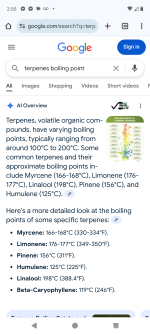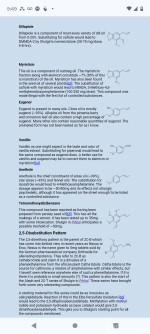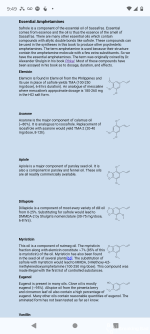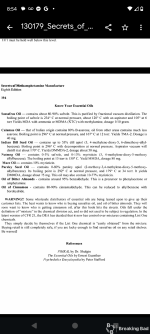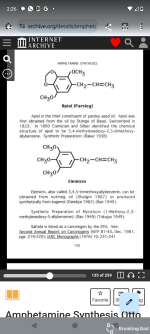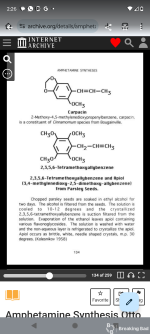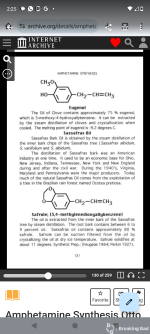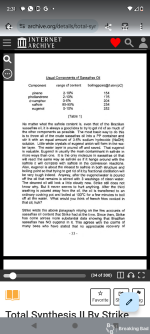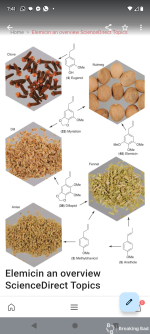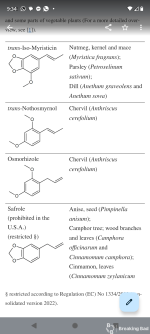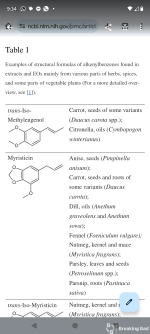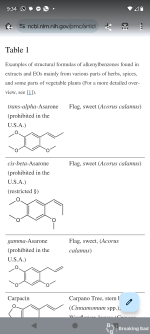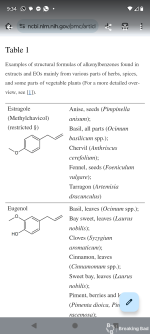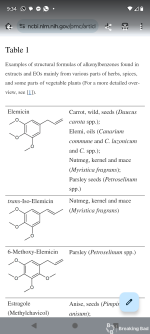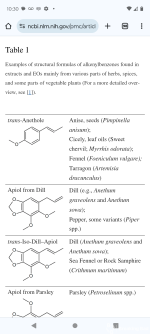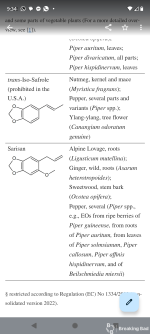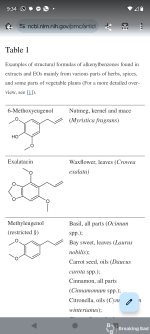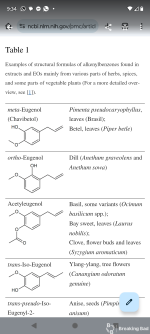- Language
- 🇺🇸
- Joined
- May 10, 2025
- Messages
- 437
- Reaction score
- 108
- Points
- 43
Hi folks
***Swim is trying to UTFSE and is having a difficult time coming across media references of distilling certain essential oils..***
a How to SetUp a Distilling Apparatus (for beginners)
Vacuum Distillation setup
Vogel Textbook of Practical Organic Chemistry 5th Edition (image v)

The Organic Chem Lab Survival Manual -James W. Zubrick (image v)

Elemicin can be distilled from essential oils like elemi oil and nutmeg oil using vacuum distillation at reduced pressure. Elemicin is typically collected during the distillation process between specific temperature ranges at a set pressure, according to Wikipedia. For example, it was first isolated from elemi oil at 162-165 °C at 10 torr. In nutmeg oil, the distillation process is also conducted under reduced pressure to prevent myristicin decomposition, according to a study in the Journal of Young Pharmacists.
BOILING POINTS OF THE ALLYLBENZENE:
These allylbenzene oils have a higher boiling point ~200C -250C AND PHENYLACETONES TOO
The boiling point of safrole is approximately 232-234 °C (450-453 °F).
Elemicin Boiling Point. 279.8°C at 760 mmHg
Elemicin Boiling Point: 152.00 to 156.00 °C. @ 17.00 mm Hg ;
Elemicin Boiling Point: 144.00 to 147.00 °C. @ 10.00 mm Hg
Myristicin a boiling point of 276.5ºC
Asarone Boiling Point. 296 °C @ 760 MM HG
The boiling point of apiole is 294 °C (561 °F)
Dillapiole DILLAPIOLE 484-31-1 ; Boiling Point283°C at 760 mmHg
SOURCES:
Safrole- Safrole can be obtained through natural extraction from Sassafras albidum and Ocotea cymbarum. Sassafras oil for example is obtained by steam distillation of the root bark of the sassafras tree. The resulting steam distilled product contains about 90% safrole by weight. **See a cinnamon tree in southeast Asia**
Elemicin- Elemicin is a naturally occurring alkenylbenzene primarily found in the essential oils of nutmeg (Myristica fragrans) and elemi (Canarium luzonicum) high amount
Myristicin- Myristicin is a chemical compound found in nutmeg, particularly in the aromatic fraction of its essential oil. Low amount ~10% myristicin in nutmeg oil
Asarone is in a plant Calamus sweet flag in high amounts
Apiole - Apiole, also known as parsley oil, is primarily found in the essential oils of parsley, celery, and dill ~10 -50%
Dill apiole - Dillapiole is a natural compound primarily found in the essential oil of dill (Anethum graveolens) and fennel. ~10-60%
NAMES AND COORESPONDING AMPHETAMINE
Safrole - 3,4-(Methylenedioxy)allylbenzene --->
MDMA 3,4-methylenedioxymethamphetamine
[A picture of a bottle of sassafras oil] --->
[a picture of powder crystallite MDMA]
Elemicin-3,4,5-trimethoxyallylbenzene-->
TMA 3,4,5-Trimethoxyamphetamine
[A picture of a bottle of Elemi oil] --->
[a picture of powder crystallite TMA]
Myristicin - 3-methoxy,4,5-methylendioxy-allylbenzene --->
MMDA 3-methoxy-4,5-methylenedioxyamphetamine
[A picture of a bottle of Nutmeg oil] --->
[A picture of a finished product of power crystallite MMDA]
**Asarone is a propenylbenzene (not allylbenzene ) as like as isosafrole, anethole, isomyristicin**
Asarone - 1,2,4-trimethoxy-5-[(1E)-prop-1-en-1-yl]benzene --->
TMA-2 2,4,5-Trimethoxyamphetamine
[A picture of a bottle of calamus oil] --->
[A picture of powder crystallite TMA-2]
Apiole - 1-allyl-2,5-dimethoxy-3,4-methylenedioxybenzene --->
DMMDA 2,5-Dimethoxy-3,4-methylenedioxyamphetamine
[A picture of a bottle of Parsley Seed oil] -->
[A picture of power crystallite DMMDA]
Dillapiole - 1-allyl-2,3-dimethoxy-4,5-(methylenedioxy)benzene --->
DMMDA-2 2,3-dimethoxy-4,5-methylenedioxyamphetamine
[A picture of a bottle of Dill Seed oil] --->
[A picture of powder crystalline DMMDA-2]
REFERENCES:
Erowid Rhodium archives
Distil Safrole
-see the distill safrole aspect-
Myristicin composition of oil of nutmeg
TMA-2 from Sweet Flag root Calamus
Natural Phenylethylamines Precursors
Oil to Drugs

 alieninsect.substack.com
alieninsect.substack.com

 alieninsect.substack.com
alieninsect.substack.com
Alexander Shulgin "Essential Amphetamines"
Pihlal #157
P.I.H.K.A.L. book
-end of references-
*** May someone please do a video tutorial or post web links of related scientific endeavorments ***
Thank you
***Swim is trying to UTFSE and is having a difficult time coming across media references of distilling certain essential oils..***
a How to SetUp a Distilling Apparatus (for beginners)
Vacuum Distillation setup
Vogel Textbook of Practical Organic Chemistry 5th Edition (image v)
The Organic Chem Lab Survival Manual -James W. Zubrick (image v)
- Essential Oils as Source:
Elemicin is a component of essential oils like elemi oil and nutmeg oil, which are obtained through distillation or extraction of plant materials.
Elemicin can be distilled from essential oils like elemi oil and nutmeg oil using vacuum distillation at reduced pressure. Elemicin is typically collected during the distillation process between specific temperature ranges at a set pressure, according to Wikipedia. For example, it was first isolated from elemi oil at 162-165 °C at 10 torr. In nutmeg oil, the distillation process is also conducted under reduced pressure to prevent myristicin decomposition, according to a study in the Journal of Young Pharmacists.
BOILING POINTS OF THE ALLYLBENZENE:
These allylbenzene oils have a higher boiling point ~200C -250C AND PHENYLACETONES TOO
The boiling point of safrole is approximately 232-234 °C (450-453 °F).
Elemicin Boiling Point. 279.8°C at 760 mmHg
Elemicin Boiling Point: 152.00 to 156.00 °C. @ 17.00 mm Hg ;
Elemicin Boiling Point: 144.00 to 147.00 °C. @ 10.00 mm Hg
Myristicin a boiling point of 276.5ºC
Asarone Boiling Point. 296 °C @ 760 MM HG
The boiling point of apiole is 294 °C (561 °F)
Dillapiole DILLAPIOLE 484-31-1 ; Boiling Point283°C at 760 mmHg
SOURCES:
Safrole- Safrole can be obtained through natural extraction from Sassafras albidum and Ocotea cymbarum. Sassafras oil for example is obtained by steam distillation of the root bark of the sassafras tree. The resulting steam distilled product contains about 90% safrole by weight. **See a cinnamon tree in southeast Asia**
Elemicin- Elemicin is a naturally occurring alkenylbenzene primarily found in the essential oils of nutmeg (Myristica fragrans) and elemi (Canarium luzonicum) high amount
Myristicin- Myristicin is a chemical compound found in nutmeg, particularly in the aromatic fraction of its essential oil. Low amount ~10% myristicin in nutmeg oil
Asarone is in a plant Calamus sweet flag in high amounts
Apiole - Apiole, also known as parsley oil, is primarily found in the essential oils of parsley, celery, and dill ~10 -50%
Dill apiole - Dillapiole is a natural compound primarily found in the essential oil of dill (Anethum graveolens) and fennel. ~10-60%
NAMES AND COORESPONDING AMPHETAMINE
Safrole - 3,4-(Methylenedioxy)allylbenzene --->
MDMA 3,4-methylenedioxymethamphetamine
[A picture of a bottle of sassafras oil] --->
[a picture of powder crystallite MDMA]
Elemicin-3,4,5-trimethoxyallylbenzene-->
TMA 3,4,5-Trimethoxyamphetamine
[A picture of a bottle of Elemi oil] --->
[a picture of powder crystallite TMA]
Myristicin - 3-methoxy,4,5-methylendioxy-allylbenzene --->
MMDA 3-methoxy-4,5-methylenedioxyamphetamine
[A picture of a bottle of Nutmeg oil] --->
[A picture of a finished product of power crystallite MMDA]
**Asarone is a propenylbenzene (not allylbenzene ) as like as isosafrole, anethole, isomyristicin**
Asarone - 1,2,4-trimethoxy-5-[(1E)-prop-1-en-1-yl]benzene --->
TMA-2 2,4,5-Trimethoxyamphetamine
[A picture of a bottle of calamus oil] --->
[A picture of powder crystallite TMA-2]
Apiole - 1-allyl-2,5-dimethoxy-3,4-methylenedioxybenzene --->
DMMDA 2,5-Dimethoxy-3,4-methylenedioxyamphetamine
[A picture of a bottle of Parsley Seed oil] -->
[A picture of power crystallite DMMDA]
Dillapiole - 1-allyl-2,3-dimethoxy-4,5-(methylenedioxy)benzene --->
DMMDA-2 2,3-dimethoxy-4,5-methylenedioxyamphetamine
[A picture of a bottle of Dill Seed oil] --->
[A picture of powder crystalline DMMDA-2]
REFERENCES:
Erowid Rhodium archives
Distil Safrole
-see the distill safrole aspect-
Myristicin composition of oil of nutmeg
TMA-2 from Sweet Flag root Calamus
Natural Phenylethylamines Precursors
Oil to Drugs

Shulgin’s Essential Amphetamines — Part 2
Biosynthesis and chemistry of the essential amphetamines...

Shulgin’s Essential Amphetamines — Part 1
The Curious Pharmacology of Nutmeg Intoxication
Alexander Shulgin "Essential Amphetamines"
Pihlal #157
P.I.H.K.A.L. book
-end of references-
*** May someone please do a video tutorial or post web links of related scientific endeavorments ***
Thank you

